From small businesses to transport empire
Driving Business

OpenTTD, based on the commercial business simulation game Transport Tycoon Deluxe, invites you to create a transport empire on land, on water, and in the air.
Computer-based economic and transport simulation games comprising a well thought out abstraction of reality and a sufficiently sophisticated and diverse use concept can easily become addictive. And, in combination with attractive, highly detailed, but not overloaded graphics, such games can become cult classics.
SimCity [1] has lost none of its attraction since it was first published more than 20 years ago and is viewed as the starting point of an entire genre (see Table 1 for an overview). The original SimCity source code also served as the basis for Micropolis [14], which is used on the One Laptop Per Child computer.
These games differ not only in terms of visual presentation – top view, isometric view, or 3D model rotatable in all directions with various zoom levels – but in terms of their subject matter and tasks for the player. Whereas SimCity, Mobility, Lincity/Lincity NG, and Micropolis map complex urban processes with development plans, including infrastructural aspects such as electricity and water, the other programs focus exclusively on building and the profit-oriented operation of a transportation network, including route and cargo planning – a challenging task, especially with very large playing areas and in multiplayer mode.
[...]